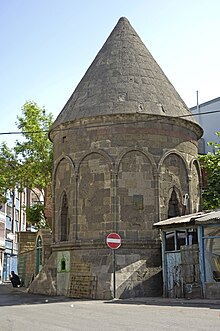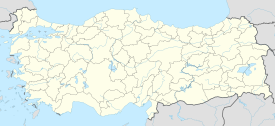Karanlik Kümbet
| Karanlik Kümbet | |
|---|---|
 | |
| Religion | |
| Affiliation | Islam |
| Province | Erzurum Province |
| Location | |
| Location | Erzurum, Turkey |
| Geographic coordinates | 39°54′38″N 41°16′44″E / 39.9106567°N 41.2788246°E |
| Architecture | |
| Type | mausoleum |
| Style | Seljuk architecture |
| General contractor | Sadreddin Türkbeg |
| Completed | 1308 |
| Materials | stone, brick |
Karanlik Kümbet (literally meaning "Dark Tomb") also known as Emir Sadrettin Kümbeti, is a historic mausoleum, or kümbet, located at Gülahmet Street of Erzurum, Turkey, opposite the Derviş Ağa Mosque.[1]
It is sometimes known as Sadrettin Konevi Türbesi and it dates back to the end of Seljuk rule in the early 14th century.[2]
History[edit]
Construction of the mausoleum started in 1307-1308[1] under Sadreddin Türkbeg, the son of an Ilkhanid governor of Khorasan.[3] The tomb was constructed in memory of his deceased father, Khoja Vecih-id-din, who was likely buried here.[3] An erroneous legend soon appeared which claimed that the Sufi mystic and disciple of Ibn Arabi, Sadreddin Konevi, was buried there.[4] This untrue legend had even made its way into the Salname-i Vilayet-i Erzurum, a history book on Erzurum.[5] Hence, the tomb became known as Sadrettin Konevi Türbesi.[5]
Modern history[edit]
The mausoleum fell into disrepair over the years. It was restored in 1954, with some funding from the Directorate General of Foundations.
Architecture[edit]

The overall architectural style of the mausoleum is classified as being in the style of Seljuk architecture.[6] The mausoleum has two levels, the actual graves are on an underground level, visible through an air vent at ground level.[3][1] A normal dome, covered by a conical one, tops the structure. Muqarnas work is present inside the building, such as the upper half of the entrance's doorway.[1][3] Stone is used primarily to construct the mausoleum.[1][3][6]
Gallery[edit]
-
Closeup of the top half of the mausoleum
-
The air vent which allows one to see the much larger rooms underground (where the real graves can be seen)
See also[edit]
References[edit]
- ^ a b c d e Kurtuluş (2020-02-12). "Erzurum: Karanlık Kümbet | Haber Kaos" (in Turkish). Retrieved 2023-12-23.
- ^ Abdürrahim Şerif Beygu, Erzurum: Tarihi, Anıtları, Kitabeleri, Istanbul 1936, pages 146-147.
- ^ a b c d e ÇAĞLAYAN, Mustafa Yılmaz (2021-01-30). "KARANLIK KÜMBET (Emir Sadreddin Kümbeti)". Erzurum Ansiklopedisi (in Turkish). Retrieved 2023-12-23.
- ^ KELEŞ, Erol (2021-06-09). "Vilâyet-i Ermen Vâlisi Emir Sutay Noyan ve Sutaylılar". Marmara Türkiyat Araştırmaları Dergisi. 8 (1): 73–90. doi:10.16985/mtad.949328. ISSN 2148-6743.
- ^ a b Salnâme-i Vilâyet-i Erzurum (1317), p. 168.
- ^ a b Mehmet Özel, “Erzurum’da Selçuklu Devri Eserleri”, Kültür ve Sanat, Istanbul 1977



